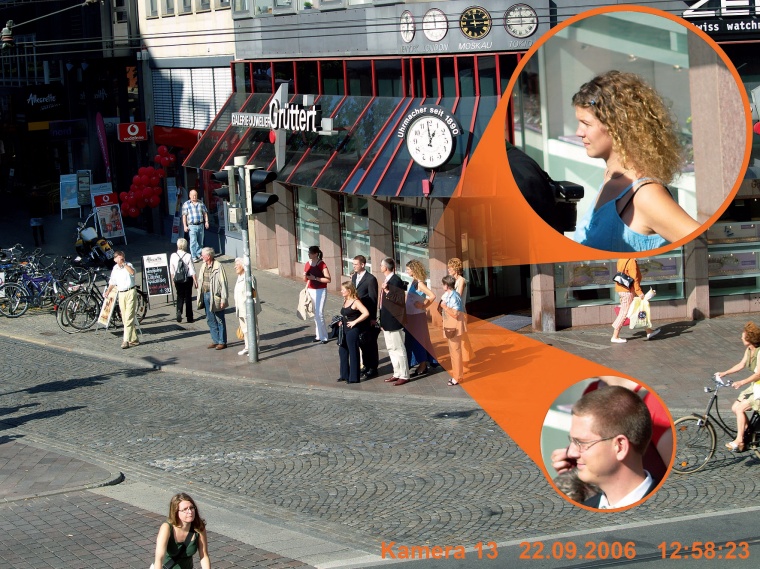Artec Technologies: HD technology and video surveillance systems
Artec Technologies: HD technology and video surveillance systems. HD stands for High Definition and is used in conjunction with HDTV for high-resolution television that offers reso...


Artec Technologies: HD technology and video surveillance systems. HD stands for High Definition and is used in conjunction with HDTV for high-resolution television that offers resolutions of up to 1,920 x 1,080 pixels. Video surveillance does not use HD cameras – instead, IP video cameras offering resolutions of up to 5 megapixels are generally available for retail purchase. By comparison, analogue video cameras offer about 414,000 pixels maximum, whereby digital recorders used for security purposes can generally only capture half-images, i.e. only about 207,000 pixels, because of interlace effect.
IP video megapixel cameras offer a level of detail precision previously unseen in surveillance. In practical circumstances, a single 5 megapixel camera can replace up to six analogue cameras. The picture rates have also made significant progress: a 5 megapixel camera can currently supply up to 10 pictures per second.
These highresolution cameras are becoming increasingly popular and are already being successfully deployed in wide-angle video surveillance, for example at car parks, airports, stadiums, but also for taking panoramic pictures in shops, shopping centres, or for purposes of traffic and environmental observation. Picture resolutions of this calibre demand the highest standards of the lenses. Standard lenses are of no use whatsoever. Special megapixel lenses, which the industry has recently started supplying, must be used.
Software Challenge
Processing large volumes of data presents a further challenge when using these cameras in video surveillance systems. Optimally compressed, a picture taken by a 5 megapixel camera can be as large as 950kByte. So a system comprised of five such cameras and picture rates of 4 ips each would involve transmission bandwidths of about 150 Mbps and writing speeds of about 190MByte/second. Data volumes with these dimensions are extremely challenging for the network and the recording system.
The IT world is unperturbed by these performance requirements: They can be serviced using 1 GB networks and RAID servers. But the standards demanded of the management and recorder software are extremely high. In the example mentioned above, picture files encompassing hundreds of megapixels have to be processed. The systems must offer features such as motion detection, motion search, or data keying, just like their conventional counterparts.
Added to which, the software must be extremely flexible and support a wide range of IP cameras and video servers from different manufacturers. Remote access to systems using megapixel cameras represents a further major challenge. This is, of course, not possible using standard networks and DSL lines. Megapixel cameras are frequently offered with a dual stream system, i.e. one MPJEG stream for recording and a low-resolution MPEG4 real-time stream for remote access.
In such cases, the major advantage of megapixel cameras - their digital live zoom capabilities - is taken ab absurdum. Resolution reverts back to analogue capabilities; i.e. the picture quality does not improve. Innovative technology has produced new solutions to this problem: The MJPEG stream of the megapixel cameras is simultaneously encoded by the recorder software into an MPEG4 stream with adjustable resolution.
When digitally zooming, the maximum possible number of pixels of the resolution of the cropped image is transmitted. Remote access to a 5 megapixel camera with 4 ips then only requires a bandwidth of 250kbps maximum. Using this dynamic resolution, a megapixel camera in a network works in exactly the same way as you are used to when digitally zooming in your digital camera.
The analysis of pictures with large resolution formats also prenecessitates superior technology in order, e.g., to allow the rapid detection of changes to masked parts of recorded pictures (motion search). Thanks to new indexing methods, several terabytes of video data can be analysed and displayed via the network in just a few seconds.
Megapixel or Analogue?
Analogue cameras remain very important, in spite of the enormous quality advantages offered by megapixel cameras. The benefits offered by the wide range of models, low prices, simple installation and configuration remain undisputed. In many cases, an analogue camera is perfectly adequate.
Many IP cameras with VGA resolution produce picture qualities that are inferior even to analogue cameras. Megapixel cameras only really offer advantages when the costs of new installation or upgrading are lower by comparison than analogue cameras, or if the high level of picture quality offers advantages to the customers - for example for evaluation purposes.
The current champion’s league is dictated by a combination of analogue and IP cameras within one system, i.e. hybrid video surveillance. The benefits of both technologies are put to best use. Irrespective of whether hybrid system or pure IP video surveillance - both require the competency and expertise of designers and IT system houses.
These must be able to choose the right cameras and technology to suit the client’s project, to provide the client with competent technological information and to communicate the cost efficiency of the components to be used. Anyone who has ever experienced a hybrid system with megapixel cameras will never want to change.
Demonstrating analogue and megapixel side by side, e.g. on a laptop, allows customers to form their own opinions of the advantages and disadvantages.
Hybrid video recorders, state of the art management software and megapixel technology are the success factors for innovative video systems and for modernising older video systems. Anyone who acquires the technological expertise today will be the winner tomorrow.
Contact:
Ingo Hoffmann
Artec Technologies AG,
Diepholz, Germany
Tel.: +49 5441 5995 16
Fax: +49 5441 5995 70
ingo.hoffmann@artec.de
www.artec.de
most read

VIP-Lounge Interview: Marco Mille, Global Head of Security, Siemens AG
VIP in the World of Security: Marco Mille, Global Head of Security at Siemens AG

Airbus Defence and Space: Security as a strategic pillar of Europe's defense capability
Airbus Defence and Space protects sites, technologies and employees with modern security and cyber solutions - strengthening Europe's resilience in uncertain times

The Benefits of AI-based Video Surveillance Solutions for Sports Venues
Dallmeier Interview: Artificial intelligence Makes Stadiums Smarter


GIT SECURITY AWARD 2026 - The winners have been announced!
GIT SECURITY AWARD 2026: The best safety and security solutions of the year - now an overview of all winners









